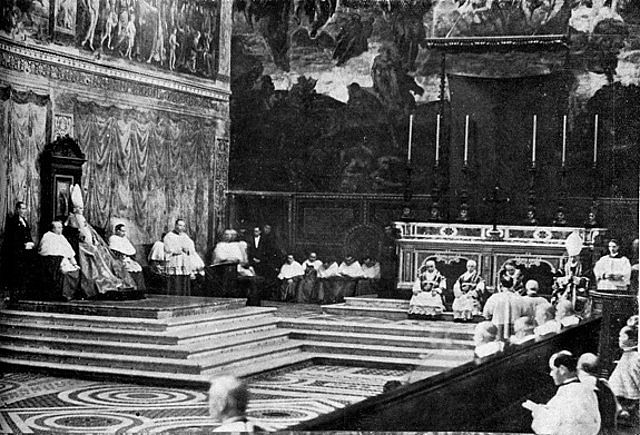

Pope Pius XI assists at the Good Friday Liturgy in the Sistine Chapel. The Celebrant is Cardinal Pacelli – the future Pope Pius XII.
The Solemn Liturgical Action of this afternoon consists of four parts, which we now proceed to explain. First of all, we have the Lessons; next, the Solemn Orations; thirdly, the Veneration of the Cross; and lastly, the Mass of the Presanctified. These solemn and unusual rites announce to the faithful the sacredness of this day, as also the suspension of the Holy Sacrifice, for which they are substituted. The altar is stripped – even the cloths, cross and candles are absent; everything in the sanctuary bespeaks mournfulness. The celebrant and sacred ministers approach the altar; their black stoles denote the grief of holy Church. On reaching the foot of the altar, they prostrate and pray in silence. The celebrant then rises, while all else remain kneeling.
The Liturgy begins with a single oration recited by the celebrant:
O God, Who by the Passion of Christ, Our Lord, hast destroyed the hereditary death of the ancient sin, to which humankind had succumbed: grant that we may be made like to Him and, just as by necessity we have borne the image of an earthly nature, so by sanctification we may also bear the image of heavenly grace. Through the same Christ Our Lord. R. Amen.
The Lessons consist of two prophetic passages from the Old Testament together with the Passion according to St. John. The first passage is from the prophet Osee (6: 1-6), and tells us of the merciful designs of God in favor of His new chosen people, the Gentiles, who were dead (in sin), and who, nevertheless, were to rise again in three days with Christ, Whom they do not yet so much as know:
...Come, and let us return to the Lord, for He has taken us, and He will heal us, He will strike, and He will cure us. He will revive us after two days: on the third day He will raise us up and we shall live in His sight...
Ephraim and Juda are to be treated otherwise: their material sacrifices have not been acceptable to God, Who loves mercy above every other gift, and rejects the offerings of those whose hearts are filled with bitterness:
...For I desired mercy and not sacrifice: and the knowledge of God more than holocausts.
The Responsory is taken from the canticle of the prophet Habacuc. It foretells the second coming of Christ, when He shall come in glory and majesty to judge them that have crucified Him:
O Lord, I have heard Thy hearing and was afraid: I have considered Thy works and trembled. V. In the midst of two animals Thou shalt be made known (the ox and ass at His birth; or the two thieves at His crucifixion): when the years draw near Thou shalt be known: when the time shall come (of the Last Judgment), Thou shalt be manifested...
At the end of the Responsory, all rise; the celebrant, standing at the sedilia, sings, Oremus (Let us pray). If there is a deacon assisting, he sings, Flectamus genua (Let us kneel). All kneel in silent prayer for a moment, until the deacon sings, Levate (Arise). If there is no deacon, the celebrant himself sings all the above. The Church sums up, in the following Oration, the prayers of Her children. She reminds our Heavenly Father of His justice towards Judas and His mercy towards the good thief, and begs that every remnant of the old man may be removed from us, and we may rise again with Our Lord Jesus Christ:
O God, from Whom Judas received the punishment of his guilt, and the thief, the reward of his confession, grant unto us the full fruit of Thy clemency; that even as in His Passion, Our Lord Jesus Christ gave to each a retribution according to his merits, so, having taken away our past sins, He may bestow on us the grace of His Resurrection. Who with Thee... R. Amen.
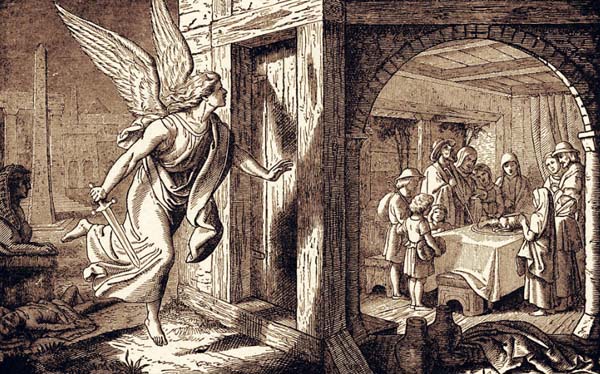 The second Lesson now follows. It is taken from the Book of Exodus, and describes to us the ancient
rite of the paschal lamb, which was the figure of the reality that is given us today. It is to be a lamb without
spot or blemish. Its blood has the power of preserving from death those whose dwellings are sprinkled with it.
It is not only to be immolated; it is to be eaten by them that have been saved by it. It is to be the food of the wayfarer;
and they who partake of it must stand while they eat, like unto men who have no time to lose during this passing life.
Its immolation is the signal of the Pasch; the immolation of our Emmanuel, Jesus, the Lamb of God, is the signal of our Pasch:
The second Lesson now follows. It is taken from the Book of Exodus, and describes to us the ancient
rite of the paschal lamb, which was the figure of the reality that is given us today. It is to be a lamb without
spot or blemish. Its blood has the power of preserving from death those whose dwellings are sprinkled with it.
It is not only to be immolated; it is to be eaten by them that have been saved by it. It is to be the food of the wayfarer;
and they who partake of it must stand while they eat, like unto men who have no time to lose during this passing life.
Its immolation is the signal of the Pasch; the immolation of our Emmanuel, Jesus, the Lamb of God, is the signal of our Pasch:
...It shall be a lamb without blemish, a male, of one year... and the whole multitude of the children of Israel shall sacrifice it in the evening. And they shall take of the blood thereof, and put it upon both the side posts, and on the upper door posts of the houses, wherein they shall eat it... You shall gird your reins, and you shall have shoes on your feet, holding staves in you hands, and you shall eat in haste; for it is the Phase (that is, the Passage) of the Lord.
This magnificent prophecy is followed by a Responsory taken from Psalm 139, in which the Church represents our Redeemer (Who has been betrayed into the hands of His enemies) praying to His Eternal Father:
Deliver me, O Lord, from the evil man: rescue me from the unjust man. Who have devised iniquities in their hearts... Who have proposed to supplant my steps. The proud have hidden a net for me...
The prophets have prepared us for the fulfilment of their types. Holy Church is now going to relate to us the history of our Savior's Passion. It is St. John, the fourth of the Evangelists, and an eyewitness of what took place on Calvary, who is about to describe to us the last moments of Jesus' mortal life.
If circumstances permit, the Passion is chanted by three deacons: one singing the words of Our Divine Lord; another, called Chronista, acts as narrator; the third, called Synagoga, supplies the voices of all others. Let us be all attention, and beg Our Lord to give us something of that devotion, which filled the soul of His beloved disciple as he stood at the foot of the Cross. It is St. John who relates the touching last words of Jesus to His Holy Mother:
...When Jesus therefore, saw His Mother and the disciple standing by, whom He loved, He said to His Mother,
Woman, behold Thy Son.
Then He said to the disciple, Behold thy Mother.
And from that hour the disciple
took Her into his home...
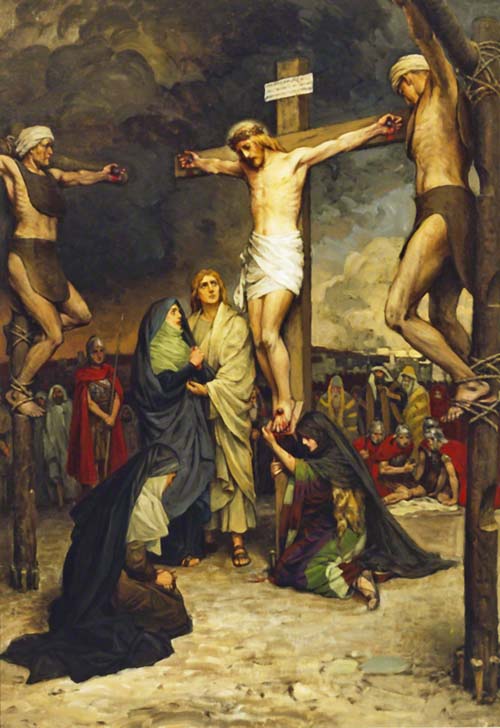 Having thus described to us the Passion and Death of Her Divine Spouse, the Church would follow
the example set Her by this the Mediator of the world. St. Paul tells us that Jesus, when dying on the Cross,
offered up to His eternal Father, for all mankind, prayers and supplications, with a strong cry and tears (Heb. 5: 7).
Therefore it is that, from the earliest ages, the Church has presented to the Divine Majesty, upon this day,
a solemn formula of prayers, in which She intercedes for the necessities of the whole world.
How truly is She the Mother of men, and the affectionate Bride of Jesus! All, even the Jews,
are included in this Her intercession, which She makes, under the shadow of the Cross, to the Father of all ages.
Having thus described to us the Passion and Death of Her Divine Spouse, the Church would follow
the example set Her by this the Mediator of the world. St. Paul tells us that Jesus, when dying on the Cross,
offered up to His eternal Father, for all mankind, prayers and supplications, with a strong cry and tears (Heb. 5: 7).
Therefore it is that, from the earliest ages, the Church has presented to the Divine Majesty, upon this day,
a solemn formula of prayers, in which She intercedes for the necessities of the whole world.
How truly is She the Mother of men, and the affectionate Bride of Jesus! All, even the Jews,
are included in this Her intercession, which She makes, under the shadow of the Cross, to the Father of all ages.
The celebrant dons a black cope; if he is assisted by sacred ministers, they don a black dalmatic and tunic. A single cloth is spread on the altar and the Missal is place in the middle. The celebrant ascends and kisses the altar; he then stands before the Missal.
Each of these prayers is prefaced by a few words, which show its object. As before, the deacon or celebrant bids the faithful to genuflect and then rise to unite in each solemn oration. The first of these is for Holy Church; the second for the Holy Father; the third for All Orders and Degrees of the Faithful; the fourth for Civil Authorities; the fifth for Catechumens; the sixth for the Needs of the Faithful; the seventh for the Unity of the Church; the eighth for the Conversion of the Jews; and finally, the ninth for the Conversion of Pagans:
Let us pray also for the pagans, that Almighty God may remove iniquity from their hearts, that, putting aside their idols, they may be converted to the true and living God, and His only Son, Jesus Christ our God and Lord.
Oremus. V. Flectamus genua. R. Levate.
Almighty and everlasting God, Who always seekest not the death, but the life of sinners, mercifully hear our prayer, and deliver them from the worship of idols, and join them to Thy holy Church for the praise and glory of Thy Name. Through Our Lord Jesus Christ... R. Amen.
The Solemn Orations are ended. The charity and zeal of the Church have embraced the whole universe of men, invoking upon them the merciful effusion of the Precious Blood, the Church turns next to Her faithful children. Filled with holy indignation at the humiliations heaped upon Her Jesus, She invites us to a solemn act of reparation: it is to consist in venerating that Cross which our Divine Lord has borne to the summit of Calvary, and to which He is to be fastened with nails. The Cross is a stumbling-block to the Jews, and foolishness to the Gentiles (1 Cor. 1: 23); but to us Christians it is the trophy of Jesus' victory, and the instrument of the world's redemption. It is worthy of our deepest veneration, because of the honor conferred upon it by the Son of God: He consecrated it by His own Blood, He worked our salvation by its means. No time could be more appropriate than this for honoring it with the humble tribute of our veneration.
The holy ceremony of venerating the Cross on Good Friday was first instituted in Jerusalem, in the 4th century. Owing to the pious zeal of the Empress St. Helena, the True Cross had then recently been discovered, to the immense joy of the whole Church. The faithful, as might be expected, were desirous of seeing this precious relic, and accordingly it was exposed every Good Friday. This brought a very great number of pilgrims to Jerusalem; and yet how few, comparatively, could hope to have the happiness of such a visit, or witness the magnificent ceremony! An imitation of what was done on this day at Jerusalem was a natural result of these pious desires. It was about the 7th century, that the practice of publicly venerating the Cross on Good Friday was introduced into other churches. True, it was but an image of the True Cross that these other churches could show to the people; but as the respect that is paid to the True Cross refers to Christ Himself, the faithful could offer Him a like homage of adoration, even though not having present before their eyes the sacred wood which had been consecrated by the Blood of Jesus. Such was the origin of the imposing ceremony at which holy Church now invites us to assist.
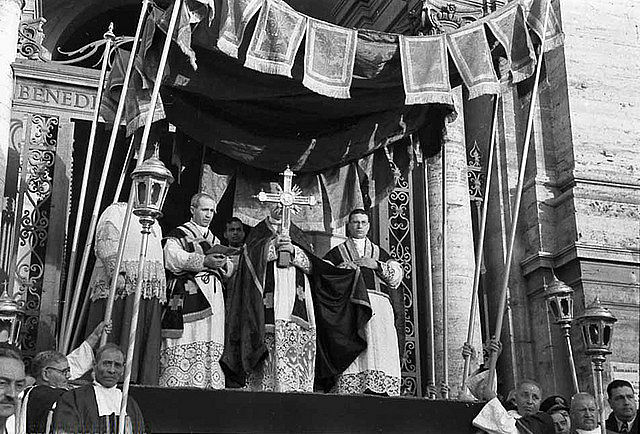
Veneration of the Relic of the True Cross at the Lateran Basilica.
The celebrant removes the cope, in order that the reparation, which he is to be the first to offer to our outraged Jesus, may be made with all possible humility. He then stands near the Epistle side of the altar, and turns towards the people. The deacon gives the Cross to the celebrant, who then unveils the upper part only. He raises it a little, and sings these words: Behold the wood of the Cross on which hung the salvation of the world. All genuflect and adore the cross, while the choir sings: Come, let us adore.
This first exposition, which is made at the side of the altar, and in a low tone of voice, represents the first preaching of the Cross, that, namely, which the Apostles made, when, for fear of the Jews, they dared not to speak of the great mystery except to a few faithful disciples of Jesus. For the same reason, the priest but slightly elevates the cross. The homage here paid to it is intended as a reparation for the insults and injuries offered to our Redeemer in the house of Caiphas.
The celebrant then comes nearer to the middle of the altar. He unveils the right arm of the Cross, and holds up the holy Sign of our redemption higher than the first time. He then sings the Ecce lignum on a higher note. All genuflect and adore while the choir responds as before.
This second elevation of the holy Cross signifies the Apostles' extending their preaching of the mystery of our redemption to the Jews, after the descent of the Holy Ghost; by which preaching they made many thousand converts, and planted the Church in the very midst of the Synagogue. It is intended as a reparation to our Savior, for the treatment He received in the court of Pilate.
The priest then advances to the middle of the altar, and, with his face still turned towards the people, he removes the veil entirely from the Cross. He elevates it more than he did the two preceding times, and triumphantly sings on a still higher note the Ecce lignum. The people fall down upon their knees, and the choir sings again: Come, let us adore.
This third and unreserved manifestation represents the mystery of the Cross being preached to the whole earth, when the Apostles, after being rejected by the majority of the Jewish people, turned towards the Gentiles, and preached Jesus crucified even far beyond the limits of the Roman Empire. It is intended as a reparation to our Lord for the outrages offered to Him on Calvary.
There is also another teaching embodied in this ceremony of holy Church. By this gradual unveiling of the Cross, She would express to us the contrast of the Jewish and Christian view. The one finds nothing in Christ crucified but shame and ignominy; the other discovers in Him the power and wisdom of God (1 Cor. 1:24). Honor, then, and veneration be to His Cross, now that the veil is removed by our Faith! Unveiled let it be upon our altar, for He that died upon it is soon to triumph by a glorious Resurrection! Yes, let every crucifix in our churches be unveiled, and every altar beam once more with the vision of the glorious standard!
But the Church is not satisfied with showing Her children the Cross that has saved them; She would have them approach, and kiss it. The celebrant leads the way. He has already taken off his cope; he now takes off his shoes also, and then advances towards the place where he has put the crucifix. He makes three genuflections at intervals, and finally kisses the Cross. The clergy follow him, and then the people.
The chants which are used during this ceremony are exceedingly beautiful. First of all, there are the Improperia, that is, the reproaches made by our Savior to the Jews. Each of the first three stanzas of this plaintive hymn is followed by the Trisagion, or prayer to the thrice-holy God, Who, as Man, suffers death for us. Oh! let us fervently proclaim Him to be the Holy, the Immortal! This form of prayer was used at Constantinople, as far back as the 5th century. The Roman Church adopted it, retaining even the original Greek words, to which, however, she adds a Latin translation. The rest of this beautiful chant contains the comparison made by our Lord between the favors He has bestowed upon the Jewish people, and the injuries He has received from them in return:
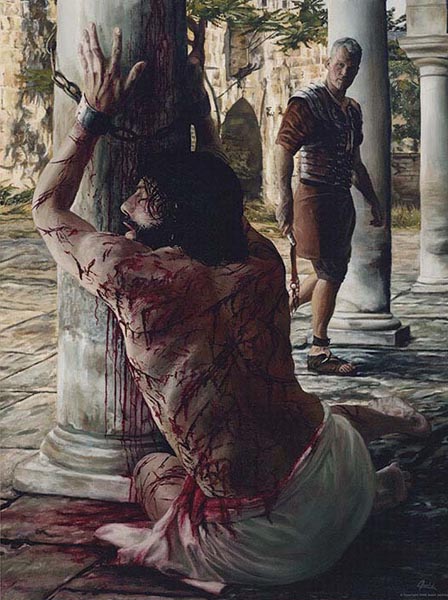 O my people, what have I done to thee, or in what have I grieved thee? Answer Me.
Because I brought thee out of the land of Egypt, thou hast prepared a Cross for thy Savior.
O Holy God! O Holy Mighty One! O Holy Immortal One, have mercy on us.
O my people, what have I done to thee, or in what have I grieved thee? Answer Me.
Because I brought thee out of the land of Egypt, thou hast prepared a Cross for thy Savior.
O Holy God! O Holy Mighty One! O Holy Immortal One, have mercy on us.
Because I was thy guide through the desert for forty years, and fed thee with manna, and brought thee into an excellent land, thou hast prepared a Cross for thy Savior. O Holy God...
What more should I have done to thee, and have not done? I have planted thee for My most beautiful vineyard: and thou hast proved very bitter to Me, for in My thirst thou gavest Me vinegar to drink; and didst pierce the side of thy Savior with a spear. O Holy God...
For thy sake I scourged Egypt with her first-born; and thou hast delivered Me up to be scourged. O my people, what have done to thee, or in what have I grieved thee? Answer Me.
I led thee out of Egypt, having drowned Pharoah in the Red Sea; and thou hast delivered Me up to the chief priests. O my people...
I opened the sea before thee; and thou hast opened My side with a spear. O my people...
I went before thee in a pillar of cloud; and thou hast brought Me to the court of Pilate. O my people...
I fed thee with manna in the desert; and thou hast beaten Me with buffets and stripes. O my people...
I gave thee wholesome water to drink out of the rock, and thou hast given for My drink gall and vinegar. O my people...
For thy sake I smote the kings of Chanaan; and thou has smitten My head with a reed. O my people...
I gave thee a royal scepter; and thou hast given to My head a crown of thorns. O my people...
With great might I raised thee on high; and thou hast hanged Me on the gibbet of the Cross. O my people, what have I done to thee, or in what have I grieved thee? Answer Me.
The Cross is carried back to the altar. The acolytes place the two lighted candles they have been carrying during the Veneration of the Cross upon the altar, on either side of the Cross.
So vividly is the Church impressed with the remembrance of the great Sacrifice offered today on Calvary, that She refrains from renewing on Her altars the immolation of the Divine Victim: She contents Herself with partaking of the sacred mystery by Holy Communion. With the Restored Order of Holy Week, the clergy and laity are once again permitted to communicate along with the celebrant, as they had formerly done centuries ago.
The celebrant (and sacred ministers) don violet vestments – the celebrant wearing a chasuble, as he would normally for Holy Mass. A short procession is made to transport the Blessed Sacrament from the Altar of Repose, where It has been reserved since Holy Thursday, to the main altar. Acolytes accompany the Blessed Sacrament with the two lighted candles from the Altar of Repose, and place them on the main altar – making four candles in all. In the meantime the choir sings:
We adore Thee, O Christ, and we bless Thee; because by Thy Holy Cross Thou hast redeemed the world.
By the wood (of the tree of the forbidden fruit in Eden) we have become slaves (to sin), and by the Holy Cross we have been freed: the (forbidden) fruit of the tree has seduced us, and the Son of God has redeemed us.
O Savior of the world, save us: we pray Thee, O our God, to help us, Who by Thy Cross and Blood hast redeemed us.
The Mass of the Presanctified begins with the recitation of the Pater Noster. This, the Lord's Prayer, is recited slowly and aloud by all together with the celebrant.
The celebrant alone continues with the Libera nos, which he recites aloud. All respond: Amen.
The celebrant then, in a subdued voice, recites the Perceptio – the last of the prayers which normally precede the celebrant's Communion at Holy Mass. After the Domine non sum dignus, the celebrant receives one of the Sacred Hosts. The Confiteor is recited and the absolution is given as usual. The celebrant then raises the adorable Body of our Redeemer, as Jesus was raised up on the Cross. Turning towards the people, he recites the Ecce Agnus Dei and Domine non sum dignus. The faithful, who are kneeling all the while, bow down in profound adoration before their crucified Lord. Holy Communion is then distributed in the same manner as on Holy Thursday. All who are properly disposed have the great privilege of uniting themselves personally to Jesus Crucified.
After purifying his fingers, the celebrant concludes the Liturgy with the following three prayers. All stand and respond Amen to each:
Let us pray. May Thy blessing, we beseech Thee, O Lord, descend copiously upon Thy people, who have devoutly recalled the Passion and Death of Thy Son; may Thy kindness come upon them, may Thy consolation be bestowed on them, may their holy Faith increasingly grow, may their eternal redemption be strengthened. Through the same Christ Our Lord. R. Amen.
Let us pray. Almighty and merciful God, Who, by the blessed Passion and Death of Christ hast redeemed us: preserve in us the work of Thy mercy; that, through participation in this mystery, we may live in everlasting devotion. Through the same Christ Our Lord. R. Amen.
Let us pray. O Lord, remember Thy mercies and sanctify Thy children with everlasting protection, for whom Christ, Thy Son, by His own Blood, instituted the Paschal Mystery. Through the same Christ Our Lord. R. Amen.
Contact us: smr@salvemariaregina.info
Visit also: www.marienfried.com